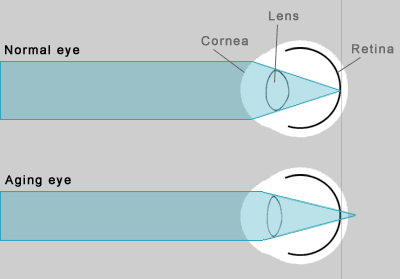|
 |
|
As you reach middle age, the
lens loses its flexibility to change shape and
the ciliary muscle weakens. This results in
light rays converging behind the retina rather
than on it Ė and diminished ability to clearly
focus on near objects such as print |
Overview
Aging eyes, medically known as presbyopia (prez-bee-OH-pee-uh),
is a condition in which the lens of the eye gradually
loses its flexibility, making it harder to focus clearly
on close objects such as printed words. Distance vision
is usually unaffected.
Presbyopia, which is named from the Greek words for
"old eye," is part of the normal aging process and is
easily treated with eyeglasses or contact lenses. LASIK
and other types of surgery cannot prevent or remedy this
natural occurrence, which affects nearly everyone by age
50. Once diagnosed, it should be treated quickly to
prevent complicating other vision defects like
nearsightedness, farsightedness and astigmatism.
As the lens loses its elasticity, it becomes less
capable of "bending" (with the help of the ciliary
muscle, which also weakens with age) to properly focus
light rays from different distances onto the retina. The
more a lens can "bend," the closer the eye can focus.
Presbyopia usually becomes apparent in your early- to
mid-40s, but this lens "stiffening" is actually a
gradual process that begins decades earlier, sometimes
in adolescence. The visual effects caused by presbyopia
may slowly worsen for several years, requiring new
changes in your lens prescription, but will stabilize by
age 65 or 70.
Those who are farsighted (and already have trouble
seeing near objects) may experience presbyopia earlier,
as well as people who live in tropical climates and at
sea level.
Symptoms
The first sign of presbyopia is often the need to hold
reading material at arm's length the see letters clearly
the reason why some eyecare professionals jokingly call
it "long arm syndrome." In addition to blurred vision
when reading or doing other close-vision activities at a
distance that was previously comfortable, symptoms can
include:
- Needing brighter light to see clearly
- Eye strain, fatigue or discomfort
- A decreased ability to see in darkness, and/or
increased sensitivity to glare
- Headaches, due to muscle tension or strain as
the eye tries to adjust the lens shape
If you are under age 40 and notice difficulty
reading, contact your eye doctor because these symptoms
could indicate health conditions such as anemia,
diabetes, cardiovascular problems, infections, cataracts
or sclerosis of the lens.
Prevention
Unless you can stop Father Time, you canít prevent
presbyopia, as it is an inevitable part of aging. It is
not caused, nor can it be prevented by lifestyle, diet
or visual habits. However, some people who do a lot of
close visual work such as intensive reading or computer
work may develop it earlier than others. You can help
minimize related eyestrain by taking a brief break from
close visual tasks every hour or so, and by using bright
light when reading.
Treatment
Presbyopia is completely treatable with several types of
corrective lenses. There is no surgical procedure that
has been proven effective, and even those who undergo
LASIK and other refractive surgeries will still be
presbyopic.
- Progressives. These "no-line" lenses
are the preferred choice for many presbyopes
because they correct vision at every distance,
eliminating the need for more than one pair of
glasses. Plus, unlike bifocals and trifocals,
they donít have the distinct line separating the
different visual fields, and have a more gradual
variance in visual fields. Progressive lenses
are custom-made to suit your specific work and
leisure needs.
- Bifocals and trifocals. These lenses
are sectioned into two or three parts that
correct vision at different distances. Usually,
the bottom portion of the lens corrects close
vision, while the upper portion corrects
distance vision (or is non-prescription). It may
take several weeks to adjust to bifocal lenses,
especially if you havenít previously worn
glasses.
- Single-vision reading glasses. If you
previously didnít need corrective lenses,
so-called "reading" glasses may be an option.
However, some presbyopes need more than one pair
-- one for reading and another for driving, for
example. Although inexpensive reading glasses
are readily available at drug stores and other
retails shops, they are often of poor quality
and don't correct your vision as accurately as
prescription lenses do.
- Multifocal contact lenses. Just like
in multifocal eyeglasses (bifocals, trifocals
and progressives), multifocal contact lenses
correct more than one vision problem. Different
parts of the lenses are corrected for sight at
different distances. Designs include rigid gas
permeable and soft progressive lenses.
- Monovision therapy. In this treatment
approach, one contact lens is worn in one eye
for close vision. Either another or no contact
lens is worn in the other eye for distance
vision. The brain needs some time to adjust to
the different images received from each eye, but
most people are able to see reasonably well at
both near and far distances after an adjustment
period ranging from a few hours to several
months.
|